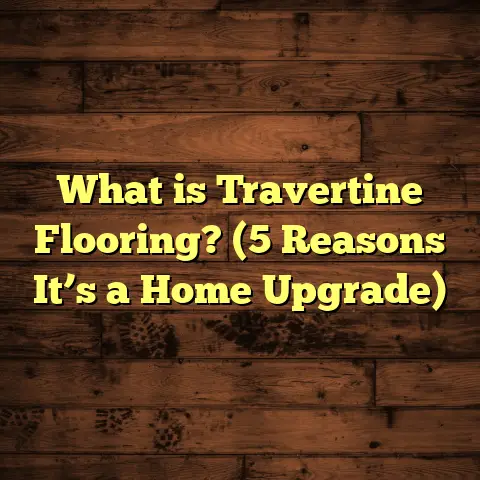What is Terraza Flooring? (5 Stylish Benefits You Didn’t Know)
Imagine walking into a space where the floor beneath your feet tells a story—an intricate tapestry of colors, textures, and history combined into one seamless surface. It’s cool to the touch yet warm in its aesthetic, blending timeless craftsmanship with modern design sensibilities. This is terraza flooring, a material that has fascinated me ever since I first encountered it on a project years ago. Since then, I’ve worked with terrazzo on everything from cozy homes to bustling commercial spaces, and every experience unearthed something new and exciting about this unique flooring.
If you haven’t heard much about terraza flooring or are wondering if it’s the right fit for your next project, stick with me. I’m going to walk you through everything I know—from what terrazzo really is, to benefits you probably haven’t heard before, down to practical tips and personal stories from the field.
What is Terraza Flooring?
Terraza flooring, or terrazzo as it’s often called, is a composite flooring material that dates back thousands of years but feels surprisingly fresh in modern design. At its core, terrazzo consists of chips of marble, quartz, granite, glass, or other aggregates embedded into a cementitious or epoxy binder. This mixture is poured or precast, then ground and polished to reveal a smooth surface that showcases the embedded chips’ patterns and colors.
Think of it as a giant mosaic—only instead of small pieces set into grout, the terrazzo is a continuous surface that feels solid underfoot and beautifully artistic.
A Brief History
This flooring has roots that stretch back to ancient Egypt and Rome, where artisans used stone fragments in floors and walls for both decoration and durability. The technique was revived and refined in 15th-century Venice by Venetian workers who used leftover marble chips from larger projects to create affordable yet attractive flooring.
Fast forward to the 20th century, terrazzo became popular in public buildings, airports, schools, and hospitals due to its durability and ease of maintenance. Today, it’s experiencing a renaissance in residential interiors as designers and homeowners seek materials that combine longevity with style.
Types of Terrazzo
There are primarily two types of terrazzo flooring I’ve worked with:
- Cement-based terrazzo: Traditional terrazzo uses cement as the binder. It’s eco-friendly and cost-effective but requires a curing period and can be more prone to cracking if not installed properly.
- Epoxy-based terrazzo: This uses epoxy resin as the binder. It allows for thinner installations, quicker curing times, and more vibrant colors. However, it’s less UV resistant and can yellow over time if exposed to direct sunlight.
I’ve found clients appreciate the epoxy option when they want bold, colorful floors indoors, while cement terrazzo is favored for outdoor patios or more natural looks.
1. Durability That Stands the Test of Time
One of the first things I learned about terrazzo is just how tough it really is. When I installed terrazzo flooring in a busy commercial space—think heavy foot traffic from hundreds of visitors daily—I was impressed by how well it held up after years of use.
According to data from the National Terrazzo & Mosaic Association (NTMA), terrazzo floors can last 40 to 75 years or more if installed and maintained correctly. That’s significantly longer than wood or laminate floors that often need replacement every 10–15 years.
Why is terrazzo so durable? It comes down to its composition and installation method. The embedded stone chips create a dense surface that resists scratches, stains, and wear far better than softer materials. Plus, when polished, the epoxy or cement matrix hardens into a robust shell that can handle impact without chipping easily.
In fact, some of the oldest terrazzo floors in historic buildings around the world still look stunning today after decades—or even centuries—of use. That longevity translates into real savings because you’re not constantly repairing or replacing your floors.
When I advise clients about flooring options for high-traffic areas like hallways or kitchens, terrazzo is always near the top of my list precisely because of this durability.
2. Eco-Friendly Choice with Sustainable Benefits
Sustainability has become a hot topic in construction and design, and terrazzo flooring fits right into this conversation. When I started researching eco-friendly materials for my projects, terrazzo caught my attention for several reasons.
First off, terrazzo uses recycled aggregates—like crushed glass or leftover marble pieces—that would otherwise go to landfill. This recycling helps reduce construction waste significantly.
Second, the long lifespan of terrazzo means fewer replacements over time. This reduces resource use and waste compared to flooring materials that need more frequent replacement cycles.
Third, many epoxy resins used today are low-VOC (volatile organic compounds), which means they emit fewer harmful chemicals inside your home compared to some synthetic materials.
In one project where sustainability was a priority, we used recycled glass chips sourced locally for the terrazzo floor. Not only did it look beautiful with shimmering flecks catching the light, but it also contributed to LEED certification points for green building standards.
A study by the Environmental Protection Agency (EPA) highlights terrazzo as a low-impact material due to its recycled content and durability. Plus, its smooth surface reduces dust accumulation, improving indoor air quality—a big plus for allergy sufferers.
If you’re thinking about green building or want floors that align with an eco-conscious lifestyle, terrazzo is worth considering seriously.
3. Endless Design Possibilities
One thing that never ceases to amaze me about terrazzo is how creative you can get with it. The combination of different chips and bases offers nearly unlimited design options—from subtle neutrals to bold color splashes.
For example, in one custom home project I worked on, we designed a terrazzo floor with an abstract pattern inspired by local nature. We mixed white marble chips with green quartz and blue glass fragments set in a soft gray epoxy base. The result was a floor that felt like walking on a piece of art.
If you want more classic looks, terrazzo can mimic natural stone seamlessly or create geometric patterns that elevate modern interiors.
The polishing process also adds dimension by enhancing color depth and reflecting light beautifully. Some manufacturers now offer pre-cast terrazzo tiles with intricate designs if you want faster installation but still desire aesthetic flexibility.
According to industry reports, terrazzo’s ability to adapt to both traditional and contemporary styles has driven its resurgence in residential markets by over 25% growth annually over recent years.
I encourage my clients to bring samples of colors or patterns they like because terrazzo can be customized to match just about any vision—from muted earth tones to vibrant jewel tones.
4. Hypoallergenic and Easy to Maintain
One question I often get: “How easy is terrazzo to clean?” From personal experience maintaining terrazzo floors in my own home and client properties, I can confidently say it’s one of the easiest surfaces out there for cleaning.
Terrazzo has a non-porous surface that doesn’t trap dust mites, pet hair, pollen, or other allergens like carpet does. That means fewer sneezes and better air quality indoors—a big win for families with allergy concerns.
Cleaning usually involves simple sweeping or vacuuming followed by damp mopping with mild detergent. There’s no need for harsh chemicals or special treatments unless you want to restore shine after several years.
Unlike hardwood floors that may require refinishing or vinyl that can peel or fade over time, terrazzo maintains its appearance with minimal fuss. That makes it ideal for busy households or commercial spaces where regular upkeep needs to be simple yet effective.
One client with two energetic dogs told me their terrazzo floor showed no scratches after months of running paws—not something they could say about their previous wood floors!
5. Cost-Effective Over Time
Okay, here’s where things get interesting. When people first hear about terrazzo flooring costs, they often balk at the upfront price compared to cheaper alternatives like laminate or vinyl.
But here’s what I’ve learned after estimating dozens of projects: when you factor in lifespan, maintenance costs, and replacement cycles, terrazzo often comes out ahead financially in the long run.
The initial installation cost usually ranges from $20 to $45 per square foot, depending on complexity and material choice. This includes substrate prep, pouring or laying terrazzo mix, grinding/polishing, and sealing.
To get accurate estimates quickly without juggling multiple vendor quotes—as well as accounting for local labor rates—I rely on FloorTally. This tool lets me plug in exact project dimensions, choose specific materials (like marble vs glass chips), include waste factors (which can add up in custom designs), and output realistic budgets tailored to my region.
Using FloorTally helps me explain costs clearly to clients upfront so there are no surprises mid-project. Plus, it saves time by consolidating calculations into one platform rather than chasing separate quotes from suppliers and installers.
Over the life of the floor—think 30+ years—those upfront costs spread out thinly compared to replacing cheaper floors every decade or so. Plus, minimal maintenance expenses make terrazzo even more economical long term.
More Personal Stories from the Field
Let me share a couple of memorable experiences working with terraza flooring that highlight its benefits:
- Project One: A Boutique Hotel Lobby
The hotel wanted something unique yet durable enough for thousands of guests yearly. We designed custom terrazzo featuring their logo embedded in the lobby floor using colored glass chips against neutral cement base. The result was stunning; guests often paused just to admire the floor art.
Years later during renovation visits, the floor showed minimal wear despite heavy foot traffic—no cracks or stains—and cleaning remained effortless even with spills common in hospitality spaces.
- Project Two: Family Home Kitchen
This family wanted a floor combining beauty with kid-proof toughness. They chose epoxy-based terrazzo with earth tone marble chips mixed into soft beige binder. After two years of daily cooking chaos (spills included), the floor looked fresh and scratch-free.
The homeowners loved how easy it was to keep spotless without worrying about stains or damage from dropped kitchen utensils—a huge relief compared to their old hardwood floors.
Common Questions I Get About Terraza Flooring
Q: Is terrazzo cold underfoot?
A: It can be cooler than carpet or wood because stone conducts temperature well. But pairing it with radiant heating systems makes it cozy while retaining all its benefits.
Q: Can terrazzo be installed over existing floors?
A: Sometimes yes—especially if flat and stable—but usually substrate prep including removal of old flooring ensures best adhesion and longevity.
Q: How long does installation take?
A: Typical residential jobs take between 3 days to 2 weeks depending on size and complexity (including curing time). Epoxy terrazzo cures faster than cement-based.
Q: Does terrazzo crack easily?
A: Not if installed correctly with proper substrate prep and control joints; minor cracks sometimes occur but can be repaired invisibly.
Q: Can I DIY terrazzo installation?
A: It’s possible for small projects but requires specialized tools and skills for mixing, pouring, grinding/polishing—professional installers are recommended for large or complex jobs.
Final Thoughts on Terraza Flooring
Working with terraza flooring has been one of the most rewarding parts of my career as a flooring contractor. It combines beauty with strength in ways few other materials do. Whether you want a floor that lasts generations or one that expresses your creative style uniquely—terrazzo offers both.
If you’re planning a project and want honest input on whether terrazzo suits your needs (or how best to budget it), I’m happy to help share insights based on real experience plus data-backed guidance using tools like FloorTally for cost clarity.
Have you ever considered terrazzo flooring? Or maybe you have questions based on what you’ve read here? Feel free to ask—I love talking about this material!





